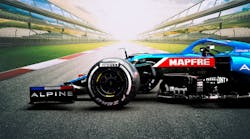Formula 1 racing cars can reach speeds of more than 220 mph, so parts reliability is a critical consideration. The weight of the car also is important, which leads car designers to develop innovative solutions to meet both requirements.
The Alpine 1 racing team designed a hard-line damper, which is part of a rear heave damper in the rear suspension system inside the car’s gearbox main case. A long, rigid piece of tubing, the accumulator stores and releases energy in order to average out pressure fluctuations. The performance of the line damper is related to its internal volume, and as such the length of the component.
The Application Innovation Group (AIG) at 3D Systems developed a design and manufacturing process for the component using titanium for both strength and weight. It uses additive manufacturing (AM) to save space and weight while achieving the required tolerances. “We designed this part to be as volumetrically efficient as possible, and to share wall thickness between adjacent tubes,” said Pat Warner, advanced digital manufacturing manager at Alpine F1 Team in a press release. “Achieving this volume is only possible with AM.”
The final titanium dampening coil used 3D Systems’ DMP machines create a strong, precise part that is both clean and repeatable for future needs.
The lessons learned from this high-speed challenge have implications for other AM projects in automotive and elsewhere. Machine Design discussed some of those applications with Kevin Baughey, segment leader for transportation & motorsports at 3D Systems:
Machine Design: First, talk about some of the complexities faced by Formula 1 racing teams as they pursue both speed and reliability. How has additive manufacturing in general helped meet these goals?
Kevin Baughey: In terms of helping with speed and reliability, AM allows Formula 1 teams to iterate designs in a matter of hours, which allows them more testing cycles to ensure the parts are working properly. AM also optimizes the constrained time teams have for wind tunnel testing by rapidly printing and integrating parts into the model. Turnaround time between races is extremely tight, and AM is significantly quicker than traditional manufacturing to help facilitate having parts ready for the next race and those that follow
MD: Let’s now talk about the specific titanium hydraulic part you’ve developed for the Alpine F1 team. What does it do for the car? What was needed in terms of design improvements to help improve its performance?
KB: For the hydraulic accumulator, specifically a rear heave fluid inerter coil, the Alpine F1 Team designed a hard-line damper, which is part of a rear heave damper in the rear suspension system inside the gearbox main case. A long, rigid piece of tubing, the accumulator store, and releases energy in order to average out pressure fluctuations. As such, the performance of the line damper is correlated to its internal volume, and thus the length of the component.
MD: One of the inherent advantages of additive manufacturing is its rapid prototyping capabilities. How did you work with Alpine’s engineers to evaluate and test various design iterations? And how long did that process take?
KB: That process is continual. Design iteration timelines differ depending on the application, with some parts only being used for a single race and others that are used throughout the season. 3D Systems works closely with the Alpine F1 Team’s designers and engineers on the schedule they need to meet, and then we maximize the time available for iteration, fit and function testing, and aerodynamic testing.
MD: What other technologies are involved in bringing these designs to the race car? And what other considerations are involved in both the design and production process?
KB: A race team will utilize several different AM technologies for prototyping and end-use parts. Stereolithography, powder sintering of metals and plastics, and extrusion will all be implemented in some capacity. Some key considerations in design and production are in the areas of lightweighting, complex part design and constrained packaging space, as AM excels in producing parts with high strength-to-weight ratios, parts with sharp edges and intricate curved designs, and parts that are constrained in the space they need to fit into, like the hydraulic accumulator.
MD: What lessons has 3D Systems taken from this experience that you can apply to other customers? And as manufacturers explore AM for their own facilities, what are some of the key questions they need to ask?
KB: Each application that is solved with AM represents a learning experience for us. Years of optimizing part design have provided us the expertise to balance part performance with the correct weight and mass needed. Designing for additive is unique in that conditions like shrinkage and growth in the build chamber have to be accounted for in the initial phases of design. Understanding this allows us to pass along best practices to customers in other industries.
In addition, working closely with manufacturing environments allows us to answer many key questions, such as how much space will be needed for an AM department, what types of post-processing equipment will be utilized, what precautions have to be used when handling powder or resin, and how will AM equipment work into an integrated production workflow that includes traditional manufacturing, CNC machines and testing/inspection equipment.



